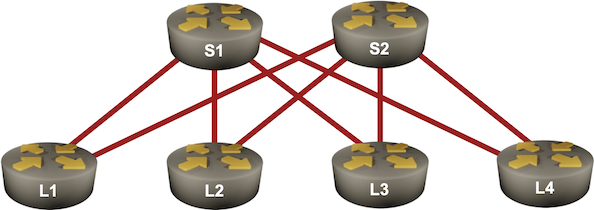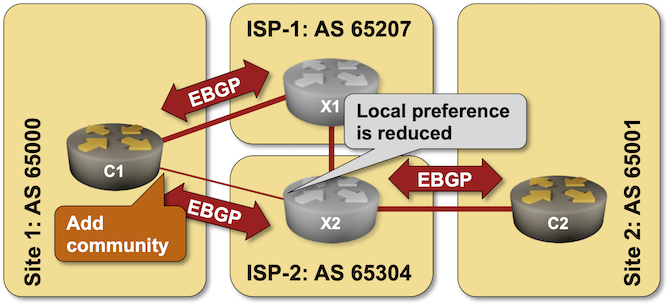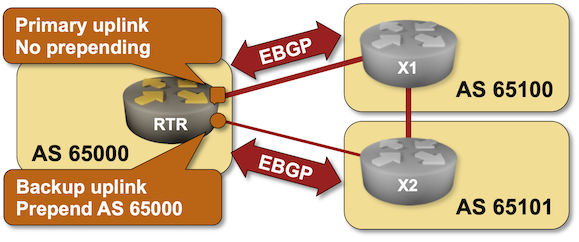Video: netlab IP Address Management (IPAM)
Did you know that netlab includes full-blown IP address management? You can define address pools (or use predefined ones) and get IPv4 and IPv6 prefixes from those pools assigned to links, interfaces, and loopbacks. You can also assign static prefixes to links, use static IP addresses, interface addresses as an offset within the link subnet, or use unnumbered interfaces.
For an overview of netlab IPAM, watch the netlab address management video (part of the Network Automation Tools webinar), for more details read the netlab addressing tutorial.
AMS-IX Outage: Layer-2 Strikes Again
On November 22nd, 2023, AMS-IX, one of the largest Internet exchanges in Europe, experienced a significant performance drop lasting more than four hours. While its peak performance is around 10 Tbps, it dropped to about 2.1 Tbps during the outage.
AMS-IX published a very sanitized and diplomatic post-mortem incident summary in which they explained the outage was caused by LACP leakage. That phrase should be a red flag, but let’s dig deeper into the details.
BGP Labs: Use BGP Route Reflectors
In the previous BGP labs, we built a network with two adjacent BGP routers and a larger transit network using IBGP. Now let’s make our transit network scalable with BGP route reflectors, this time using a slightly larger network:

netlab 1.7.0: Lab Validation, Fabrics, BGP Nerd Knobs
It’s been a while since the last netlab release. Most of that time was spent refactoring stuff that you don’t care about, but you might like these features:
- You can run automated lab validation tests with the netlab validate command. I will explain how I use that in BGP labs in a few days.
- If you want to build large leaf-and-spine topologies, you’ll love the fabric plugin.
- The bgp.domain plugin allows you to create topologies with multiple sites using the same BGP AS number.
- The bgp.policy plugin got AS-path prepending.
- bgp.originate plugin can be used to originate BGP IPv4 and IPv6 prefixes.
As always, we also improved the platform support:
The BGP Origin Attribute
Kristijan Taskovski asked an interesting question related to my BGP AS-prepending lab:
I’ve never personally done this on the net but….wouldn’t the BGP origin code also work with moving one’s ingress traffic similarly to AS PATH?
TL&DR: Sort of, but not exactly. Also, just because you can climb up ropes using shoelaces instead of jumars doesn’t mean you should.
Let’s deal with the moving traffic bit first.
Worth Reading: DNS over IPv6
What happens when you let a bunch of people work on different aspects of a solution without them ever talking to each other? You get DNS over IPv6. As nicely explained by Geoff Huston, this is just one of the bad things that could happen:
Worth Reading: Use of HTTPS DNS Resource Records
Around 30 years after we got the first website, the powers that be realized it might make sense to put this is how you access a web server information (including its IPv4 and IPv6 address, and HTTP(S) support information) directly into DNS, using HTTPS Resource Records. It took us long enough 🤷♂️
The BGP Multi-Exit Discriminator (MED) Saga
Martijn Van Overbeek left this comment on my LinkedIn post announcing the BGP MED lab:
It might be fixed, but I can recall in the past that there was a lot of quirkiness in multi-vendor environments, especially in how different vendors use it and deal with the setting when the attribute does exist or does not have to exist.
TL&DR: He’s right. It has been fixed (mostly), but the nerd knobs never went away.
In case you’re wondering about the root cause, it was the vagueness of RFC 1771. Now for the full story ;)
BGP Labs: Set BGP Communities on Outgoing Updates
It’s hard to influence the behavior of someone with strong opinions (just ask any parent with a screaming toddler), and trying to persuade an upstream ISP not to send the traffic over a backup link is no exception – sometimes even AS path prepending is not a strong enough argument.
An easy solution to this problem was proposed in 1990s – what if we could attach some extra attributes (called communities just to confuse everyone) to BGP updates and use them to tell adjacent autonomous systems to lower their BGP local preference? You can practice doing that in the Attach BGP Communities to Outgoing BGP Updates lab exercise.

Can a Router Use the Default Route to Reach BGP Next Hops?
TL&DR: Yes.
Starting with RFC 4271, Route Resolvability Condition:
- A route without an outgoing interface is resolvable if its next hop is resolvable without recursively using the same route.
- A route with an outgoing interface is always considered resolvable.
- BGP routes can be resolved through routes with just a next hop or an outgoing interface.
Worth Reading: Network Automation with GitHub Actions
George Davitiani put together a lovely proof-of-concept using GitHub actions to deploy modified configurations to network devices. Even better, he documented the whole setup, and the way to reproduce it. I’m positive you’ll find a few ideas browsing through what he did.
Worth Reading: Going CCNP Emeritus
Daniel Teycheney decided not to renew his CCNP status and used this opportunity to publish his thoughts on IT certifications. Not surprisingly, I agree with most of the things he said, but I never put it in writing so succinctly.
Red Pill Warning: Reading his blog post might damage your rosy view of the networking industry. You’ve been warned ;)
Video: Language Models in AI/ML Landscape
In September 2023, Javier Antich extended the AI/ML in Networking webinar with a new section describing large language models (LLMs), starting with how do the LLMs fit into the AI/ML landscape?
BGP Labs: AS-Path Prepending
In the previous lab, you learned how to use BGP Multi-Exit Discriminator (MED) to influence incoming traffic flow. Unfortunately, MED works only with parallel links to the same network. In a typical Redundant Internet Connectivity scenario, you want to have links to two ISPs, so you need a bigger hammer: AS Path Prepending.

Why Do We Need BGP Identifiers?
A friend of mine sent me an interesting question along these lines:
We all know that in OSPF, the router ID is any 32-bit number, not necessarily an IP address of an interface. The only requirement is that it must be unique throughout the OSPF domain. However, I’ve always wondered what the role of BGP router ID is. RFC 4271 says it should be set to an IP address assigned to that BGP speaker, but where do we use it?
Also, he observed somewhat confusing behavior in the wild:
Take two routers and configure the same BGP identifier on both. Cisco IOS will not establish a session, while IOS XR and Junos will.
I decided to take the challenge and dug deep into the bowels of RFC 4271 and RFC 6286. Here’s what I brought back from that rabbit hole:
